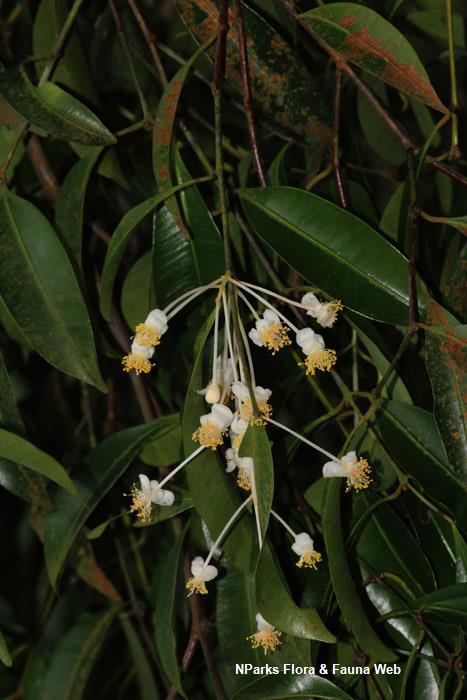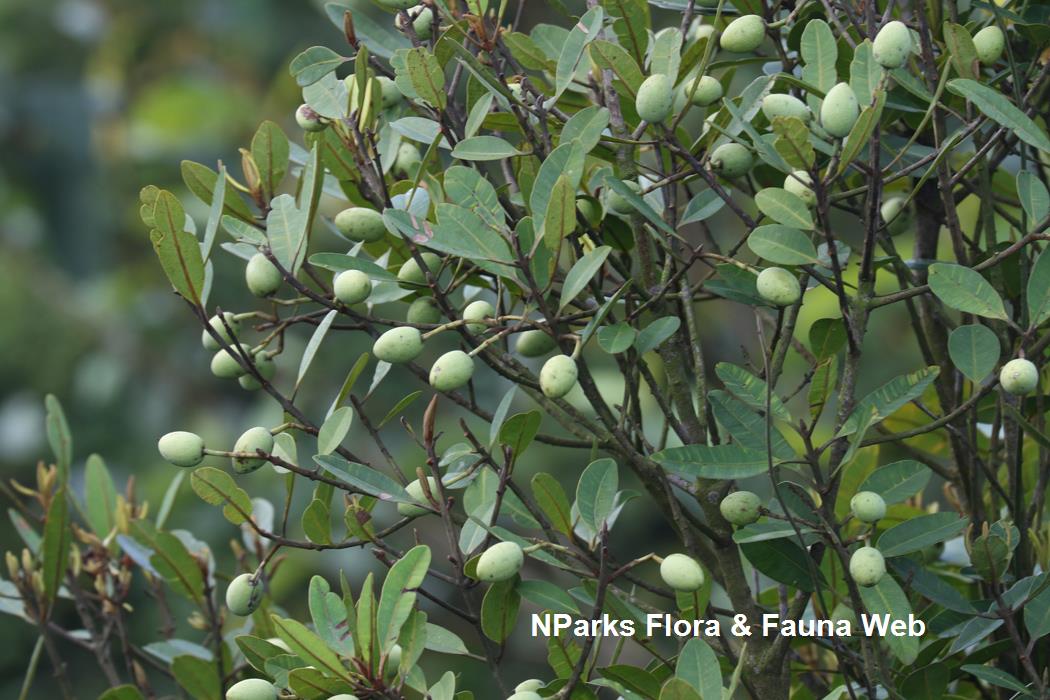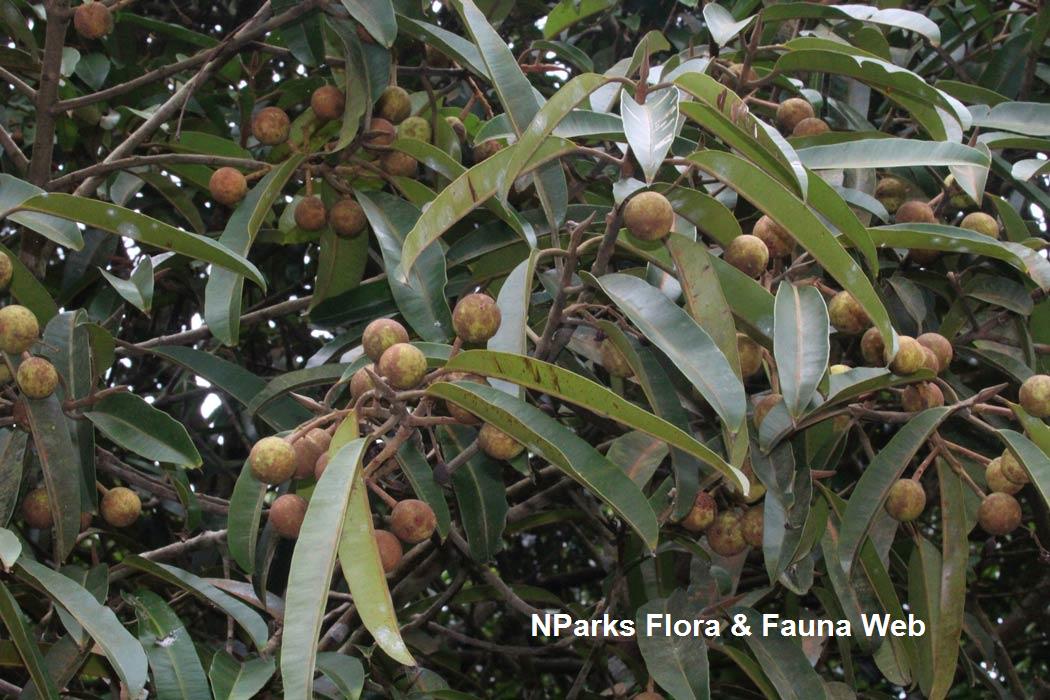
Back
Calophyllum pulcherrimum Wall. ex Choisy
| Family Name: | Calophyllaceae |
| Synonyms: | Calophyllum plicipes Miq., Calophyllum mesuifolium Wall. |
| Common Name: | Bintangor Gasing, Bintangor Batu |
Name
Classifications and Characteristics
| Plant Division | Angiosperms (Flowering Seed Plants) (Dicotyledon) |
|---|---|
| Plant Growth Form | Tree (Big (>30m)) |
| Lifespan (in Singapore) | Perennial |
| Mode of Nutrition | Autotrophic |
| Plant Shape | Oval, Irregular |
| Maximum Height | 33 m |
Biogeography
| Native Distribution | Cambodia, Peninsular Thailand, Peninsular Malaysia, Singapore, Sumatra, and Borneo |
|---|---|
| Native Habitat | Terrestrial (Primary Rainforest, Secondary Rainforest) |
| Preferred Climate Zone | Tropical, Sub-Tropical / Monsoonal |
| Local Conservation Status | Native to Singapore (Least Concern (LC)) |
Description and Ethnobotany
| Growth Form | It is a large tree, up to 33 m tall with an irregular or oval crown. |
|---|---|
| Foliage | Its stalked, oppositely-arranged leaves are 3.5-9 cm long and 1.5-3.7 cm wide, with many parallel secondary veins. |
| Flowers | Its flowers are borne on a stalked inflorescence that is 6-7 cm long. |
| Fruit | Its fleshy fruits are ovoid-ellipsoid drupes that are about 2 cm long and green in colour. |
| Associated Fauna | Its flowers are insect-pollinated. Its fruits are probably eaten by birds and other forest frugivores. |
| Cultivation | It can be propagated by seed. |
| Etymology | Greek kalos, beautiful; Greek phyllon, a leaf, referring to the plant’s beautifully-veined leaf blades; Latin, pulcherrimum, beautiful, handsome, a reference to which is unknown. |
| Ethnobotanical Uses | Edible Plant Parts : Edible Fruits Food (Fruit or Vegetable): Its edible fruits taste sour. Timber & Products: The wood is used to build houses, make fishing-stakes, and poles. It is also used for floor planks, masts, and posts. |
Landscaping Features
| Landscaping | It is suitable for gardens, parks and streetscapes. |
|---|---|
| Desirable Plant Features | Ornamental Foliage |
| Landscape Uses | General, Suitable for Roadsides, Parks & Gardens, Small Gardens, Riverine |
Fauna, Pollination and Dispersal
| Fauna Pollination Dispersal Associated Fauna | Bird-Attracting |
|---|---|
| Pollination Method(s) | Biotic (Fauna) |
| Seed or Spore Dispersal | Biotic (Fauna) |
Plant Care and Propagation
| Light Preference | Full Sun |
|---|---|
| Water Preference | Moderate Water, Lots of Water |
| Plant Growth Rate | Moderate to Slow |
| Rootzone Tolerance | Moist Soils, Waterlogged Soils (Drains Site), Well-Drained Soils, Fertile Loamy Soils |
| Propagation Method | Seed |
Foliar
| Foliage Retention | Evergreen |
|---|---|
| Mature Foliage Colour(s) | Green |
| Mature Foliage Texture(s) | Leathery, Thin |
| Foliar Type | Simple / Unifoliate |
| Foliar Arrangement Along Stem | Opposite |
| Foliar Attachment to Stem | Petiolate |
| Foliar Shape(s) | Non-Palm Foliage (Oval, Elliptical) |
| Foliar Venation | Pinnate / Net |
| Foliar Margin | Entire |
| Leaf Area Index (LAI) for Green Plot Ratio | 3.0 (Tree - Intermediate Canopy) |
Floral (Angiosperm)
| Flower & Plant Sexuality | Bisexual Flowers |
| Flower Colour(s) | White |
|---|---|
| Flower Grouping | Cluster / Inflorescence |
| Flower Location | Axillary |
| Flower Symmetry | Radial |
Fruit, Seed and Spore
| Mature Fruit Colour(s) | Green, Green - Light Green |
|---|---|
| Fruit Classification | Simple Fruit |
| Fruit Type | Fleshy Fruit , Non-Accessory Fruit |
Image Repository
Others
| Master ID | 1482 |
|---|---|
| Species ID | 2775 |
| Flora Disclaimer | The information in this website has been compiled from reliable sources, such as reference works on medicinal plants. It is not a substitute for medical advice or treatment and NParks does not purport to provide any medical advice. Readers should always consult his/her physician before using or consuming a plant for medicinal purposes. |

_lowres.jpg)
_lowres.jpg)
_lowres.jpg)
_lowres.jpg)
_lowres.jpg)
_lowres.jpg)
_lowres.jpg)
_lowres.jpg)




_lowres.jpg)


